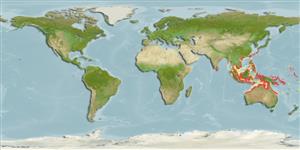分類 / Names
共通名の | 類義語 | Catalog of Fishes(部類, 種) | ITIS | CoL | WoRMS | Cloffa
板鰓亜鋼(サメとエイ類) (sharks and rays) >
Myliobatiformes (Stingrays) >
Dasyatidae (Stingrays) > Urogymninae
Etymology: Himantura: Greek, iman, imantos = thong, strap + Greek, oura = tail (Ref. 45335).
More on author: Bleeker.
Environment: milieu / climate zone / depth range / distribution range
生態学
海 底生の. Tropical; 30°N - 24°S
Indo-West Pacific: Bay of Bengal to New Guinea, north to the Ryukyu Islands, south to northern Australia. Not occurring in the western Indian Ocean.
Length at first maturity / サイズ / 重さ / 年齢
Maturity: Lm 87.5, range 85 - 90 cm
Max length : 410 cm TL オス/雌雄の選別がない; (Ref. 9840)
Demersal on soft substrate inshore (Ref.58048). Ovoviviparous (Ref. 50449). Size at birth about 20 cm WD and 92 cm TL (Ref. 90102). Caught occasionally in the demersal tangle net, bottom trawl and longline fisheries. Utilized for its meat, skin (high value) and cartilage (Ref.58048).
Life cycle and mating behavior
Maturities | 繁殖 | Spawnings | Egg(s) | Fecundities | 幼生
Exhibit ovoviparity (aplacental viviparity), with embryos feeding initially on yolk, then receiving additional nourishment from the mother by indirect absorption of uterine fluid enriched with mucus, fat or protein through specialised structures (Ref. 50449). Distinct pairing with embrace (Ref. 205). Distinct pairing with embrace (Ref. 205).
Last, P.R. and J.D. Stevens, 1994. Sharks and rays of Australia. CSIRO, Australia. 513 p. (Ref. 6871)
Human uses
水産業: 少数商業の
用具
特記事項
XMLをダウンロードして下さい
インターネットの情報源
Estimates based on models
Preferred temperature (Ref.
123201): 25 - 29, mean 28.3 °C (based on 810 cells).
Phylogenetic diversity index (Ref.
82804): PD
50 = 0.5000 [Uniqueness, from 0.5 = low to 2.0 = high].
Bayesian length-weight: a=0.00832 (0.00366 - 0.01891), b=3.10 (2.90 - 3.30), in cm total length, based on LWR estimates for this (Sub)family-body shape (Ref.
93245).
栄養段階 (Ref.
69278): 3.6 ±0.5 se; based on size and trophs of closest relatives
Fishing Vulnerability (Ref.
59153): Very high vulnerability (90 of 100).
